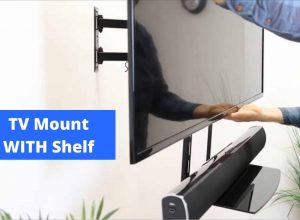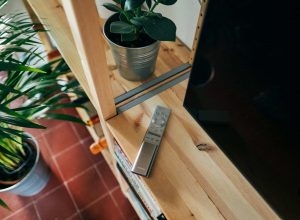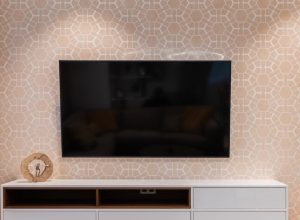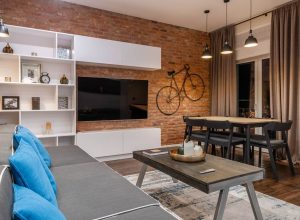Let’s address some of the most important questions when you want to decide which TV mount you should purchase:
- What size is the TV?
- What size of the mount will be compatible with your TV?
- Does the mount have enough weight capacity to support your TV?
- What are VESA patterns?
- Is the mount VESA compatible with your TV?
Once you answer these questions, you get a step closer to understanding the needs of your TV and the nature of the mount.
So we will discuss and answer all of these questions in this “What Size TV Mount Do I Need?” post.
VESA Standards

Image Courtesy: Reddit
VESA is an interface standard that is defined by the distance between the four mounting holes on the back of a TV in millimeters. These standards allow many TVs to become compatible with one type of TV mount.
How to find the VESA pattern for your TV?
The instruction manual of your TV will contain all the important details including VESA patterns.
In case you do not have the manual, you can measure the distance yourself using a measuring tape to determine the VESA pattern of your TV.
Tip:
Usually, determining the VESA pattern of your TV is enough to determine the size of wall mount you require.
Size and Weight

Image Courtesy: Reddit
The best way to ensure what size mount will be most suitable for your TV is to check the manufacturer’s manual that comes with the TV.
You can find all that you need to know in the manual including the size and weight of the TV. The larger the TV, the heavier it will be.
On the other hand, mounts have a maximum weight rating and VESA patterns. So as long as the specifications of your TV fall in line with the features of the mount, your TV will be well supported.
Mount Pressure
The most important thing is the weight the TV will put on the mount, not the screen size compatibility of a mount. You can find this information readily available online.
In some cases, it can be more helpful to purchase a mount different than the recommended size.
For Example,
It is suitable to purchase a 50” mount that can support 50 pounds rather than a 60” mount that can support a 40 pound TV.
Tip:
Purchase a mount that can hold more weight than the actual weight of your TV. This will ensure that the mount does not weaken over time. Moreover, it can be reused if you decide to purchase a heavier TV.
Wall Type

Image Courtesy: Reddit
The weight of the mount and the weight of the TV needs to be considered. If your wall is not strong enough to withstand the weight of your equipment then it can get damaged badly.
The following types of walls need to be kept in mind:
- Brick
- Concrete
- Drywall
Masonry walls such as plaster or brick walls can support heavy TVs along with mounts easily. On the other hand, drywall can become an issue.
The structure of drywalls is made up of wooden studs. It is crucial to mount your TV on these wooden studs, otherwise, the entire wall could collapse.
While you will have the complete hardware required to install the mount, you might need additional tools to drill into masonry walls. You can easily find wall anchors and bolts at hardware stores.
Tip:
Different types of wall mounts have different weights that you to keep in mind when deciding which type of wall is most suitable for a wall mount.
Fixed Wall Mounts

Image Courtesy: Reddit
As the name suggests, these wall mounts remain fixed against the wall. They cannot move or reposition once they are installed.
These mounts are typically lightweight since the only pressure in their weight is due to the mounting frame.
Tilting Wall Mounts

Image Courtesy: Reddit
Tilting wall mounts give a limited amount of post-level adjustment options. You can tilt the TV a few degrees upwards and downwards to reduce glare.
These mounts are comparatively lightweight and do not exert too much pressure by themselves on the wall.
Full Motion Wall Mounts

Image Courtesy: Reddit
Full motion mounts provide you with complete post-level adjustments to customize the perfect TV setting for you.
These mounts can:
- Swivel
- Extend
- Retract
- Rotate
- Tilt
The weight of the full-motion mounts is considerable because the full motion action is supported through the movement of dual arms. These arms tend to be quite heavy to give full support to your TV.
When installed, these mounts can exert tremendous amounts of pressure on the wall. Therefore, these types of mounts need stronger support provided by wooden studs or brick walls.
Wall Clearing

Image Courtesy: Reddit
The screen size that is advertised for a mount is best suited to be considered in cases when you want to determine the space on the wall you need to save.
This will help you prevent cramming large TVs into small spaces. You can get full-motion mounts if you have a small space to mount your large TV.
Full motion mounts can extend and adjust nicely into tiny spaces as well. Although, it can look a bit cluttered.
Final Verdict
This concludes our post on “What Size TV Mount Do I Need?” with all you need to know along with tips.
We understand that there are a lot of factors that you need to keep in mind when you want to determine the compatible size of a mount with your TV.
You can find all the relevant information in the manufacturer’s manual or on the website of the respected model.
Let us know if you have any more queries.
Adam F.
A/V and Home Theater Expert that focuses on providing clear as well as concise reviews for anything and everything Audio Visual. From TV's, TV Mounts, Soundbars, and Wiring, my focus is to provide expertise in everything Audio Visual focused.










